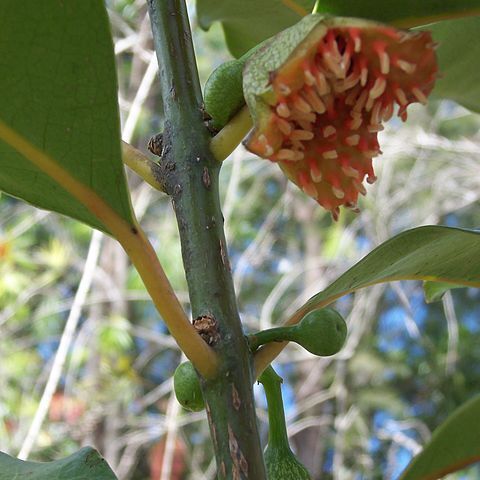Trees, shrubs or rarely climbers, often aromatic; leaves exstipulate, opposite or rarely alternate, simple, entire or toothed (the teeth sometimes glandular). Flowers small, hermaphrodite or unisexual, sometimes polygamous, often dioecious, regular or rarely irregular, arranged in axillary or terminal racemes, panicles or racemes of cymules. Perianth-lobes 4–?, small, imbricate in 2–several whorls, rarely absent. Stamens free, 6–?; anthers dehiscing introrsely or extrorsely by longitudinal slits, more rarely by valves. Ovary superior, of 1–numerous 1-locular carpels; style long or short or stigma sessile; ovules solitary in each carpel, usually anatropous, pendulous or erect. Staminodes sometimes present in the ? flowers. Fruit of l–? separate drupes or achenes, sometimes enclosed by the calyx or in or on the fleshy receptacle. Seeds with fleshy endosperm
Stamens few to numerous, 1–2-seriate or irregular, usually free; filaments very short, sometimes with glands at the base; anthers erect, 2-locular, dehiscing by longitudinal slits, or more rarely by valves
Stamens numerous or few in 1–2 series; filaments very short, often flattened, with or without glands at the base; anthers erect, 2-celled, opening by a longitudinal slit or by valves from the base upwards
Flowers actinomorphic, rarely oblique, hermaphrodite, polygamous or unisexual, cymose or racemose, rarely solitary, small or medium-sized; inflorescence axillary or rarely terminal
Ovary superior; carpels usually several, rarely solitary, 1-locular; stigma sessile or with a long or short style; ovules solitary, erect or pendulous, usually anatropous
Perianth inferior, with 4 to many often connivent teeth or lobes in 2 to many series and imbricate, equal, or the outer sepaloid and the inner petaloid, rarely obsolete
Female fl.: staminodes present or none; carpels several or rarely solitary, 1-celled; style short or elongated; stigma terminal; ovule solitary, erect or pendulous
Trees or shrubs, rarely climbers, usually fragrant, with opposite, or rarely alternate, entire or serrate, coriaceous leaves with pellucid dots; stipules absent
Leaves opposite or less often alternate, exstipulate, simple, entire or toothed, sometimes glandular-toothed, coriaceous, sometimes minutely pellucid-punctate
Flowers hermaphrodite or unisexual, actinomorphic or more rarely zygomorphic; plants monoecious, sometimes dioecious, less often polygamous
Seed erect or pendulous; testa membranous; endosperm fleshy; embryo small to half as large as the endosperm; cotyledons erect or spreading
Fruit of separate drupes, or more rarely achenes, often enclosed by the perianth or in a fleshy receptacle
Carpels separate in fruit, enclosed by the perianth or the latter deciduous, indehiscent, often drupaceous
Inflorescences axillary or terminal, racemose, cymose or fasciculate; bracts small or absent
Perianth 4–many-lobed; lobes in 2–several whorls, imbricate, rarely absent
Seeds erect or pendulous, endosperm fleshy, copious
Trees, shrubs or rarely lianes, often aromatic
Staminodes sometimes present in female flowers
Disk adnate to the perianth-tube

